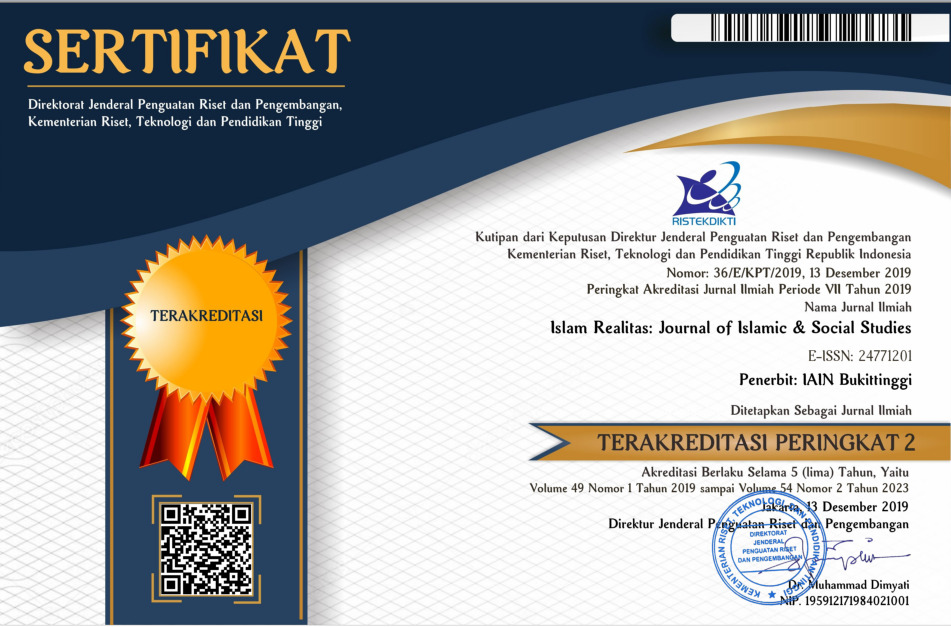Construction of the Wali Pitu’s Sacredness and Islamic Veneration in Balinese Hindu Civilization
Downloads
Additional Files
This article explains the Wali Pitu (the seven saints) as a new form of veneration dynamics in Indonesia, which was built by the sacredness of Bali as the heart of Hindu culture in Indonesia. This phenomenon is unique and interesting, because the seven tombs of Muslim saints are venerated by Hindus of the region. This study uses a qualitative approach with the case-study method, extracting data as documentation from the notes of Toyyib Zaen Arifin during the expedition to search the seven graves, and interviews with members of the Manaqib al-Jamali, guidance, organizers and religious tourism congregations, as well as several caretakers of the tombs. This article describes the sacred construction of the discovery of the seven sainthoods tombs and their cults and their dynamics as a new form of the veneration of saints in Indonesia, one that differs from the other forms of veneration in Java which has been deeply rooted for a long time, such as the Wali Songo (the nine saints).
Â
Artikel ini berupaya menjelaskan Wali Pitu (tujuh wali) sebagai bentuk baru dinamika venerasi di Indonesia yang dibangun oleh sakralitas Bali sebagai jantung peradaban Hindu. Fenomena ini sangat unik dan menarik dimana kedua korpus yang diteliti sangat kontradiktif namun menjadi sebuah realitas nyata, dimana tujuh makam wali Muslim ditemukan di Bali sebagai jantung peradaban Hindu. Menggunakan pendekatan kualitatif dengan metode studi kasus, penggalian data berupa dokumentasi dari hasil catatan Toyyib Zaen Arifin selama ekspedisi pencarian tujuh makam wali, dan wawancara kepada anggota manaqib al-Jamali, pembimbing, penyelenggara dan jama’ah wisata religi, serta beberapa juru kunci makam Wali Pitu. Artikel ini menjelaskan konstruksi sakralitas atas penemuan tujuh makam wali dan pengkultusannya serta dinamikanya sebagai wujud baru venerasi orang suci di Indonesia yang berbeda dengan venerasi sebelumnya di Jawa yang sudah mengakar kuat sejak lama (Wali Songo).
Adhika, I.M., ‘Reinvigorating Cultural Landscapes for Planning Cultural Tourism in Bali’, Geojournal of Tourism and Geosites, 33.4 (2021), 1462–69 <https://doi.org/10.30892/gtg.334spl03-594>
Ako, Mashino, and 増野亜å, ‘Being Muslim-Balinese : The Music and Identity of the Sasak Community in Eastern Bali’ (National Museum of Ethnology, 2021) <https://doi.org/10.15021/00009765> [accessed 27 August 2021]
Alatas, Ismail Fajrie, ‘Digital Theology: Saintly Marvels and God-Talk on Facebook’, CyberOrient, 15.1 (2021), 33–58 <https://doi.org/10.1002/cyo2.6>
Al-Bazzaz, ’Abd Ar-Rahman, and Sylvia G. Haim, ‘Islam and Arab Nationalism’, Die Welt Des Islams, 3.3/4 (1954), 201–18 <https://doi.org/10.2307/1570165>
Aldyan, Rizal Akbar, ‘The Commodification of Religious Tourism in the Tomb of Sunan Kudus’, Cultural Tourism Research, 2.7 (2020), 32–47 <https://doi.org/10.5281/zenodo.3692897>
Ambary, Hasan Muarif, ‘Mesjid Kampung Gelgel, Kabupaten Klungkung (Bali)’, Archipel, 30.1 (1985), 39–41 <https://doi.org/10.3406/arch.1985.2238>
Anggraeni Dyah, S., and Farhan Kahirillah Zein, ‘The Influence of Cultural Acculturation on Architecture Keraton Kasepuhan Cirebon’, in Reframing the Vernacular: Politics, Semiotics, and Representation, ed. by Gusti Ayu Made Suartika and Julie Nichols (Cham: Springer International Publishing, 2020), pp. 251–60 <https://doi.org/10.1007/978-3-030-22448-6_20>
Arjawa, I.G.P. Bagus Suka, ‘The Social Integration of Hindu and Muslim Communities: The Practice of ⇜menyama-Braya⇠in Contemporary Bali’, Studia Islamika, 28.1 (2021), 149–78 <https://doi.org/10.36712/sdi.v28i1.10914>
As’ad, Muhammad, ‘The Dynamics of the Indonesian Hadramis on the Maulid Celebration’, QIJIS (Qudus International Journal of Islamic Studies), 8.2 (2020), 389–430 <https://doi.org/10.21043/qijis.v8i2.6586>
Badan Pusat Statistik Provinsi Bali, Penduduk Provinsi Bali Menurut Agama Yang Dianut Hasil Sensus Penduduk 2010 (Bali: Badan Pusat Statistik Provinsi Bali, Pebruari 2018)
Barth, Fredrik, Ethnic Groups and Boundaries: The Social Organization of Culture Difference (Illinois: Waveland Press, 1998)
Berg, Lodewijk Willem Christiaan van den, Le Hadhramout et les colonies arabes dans l’archipel Indien (Batavia: Impr. du gouvernement, 1886)
Bruinessen, Martin van, ‘Shaykh `Abd Al-Qadir al-Jilani and the Qadiriyya in Indonesia’, Journal of the History of Sufism, 1.2 (2000), 361–95
Chambert-Loir, H., ‘Saints and Ancestors: The Cult of Muslim Saints in Java’, The Potent Dead: Ancestors, Saints and Heroes in Contemporary Indonesia, Query date: 2021-08-26 21:16:48, 2020, 132–40 <https://doi.org/10.4324/9781003118176-9>
Chambert-Loir, Henri, ‘Saints and Ancestors: The Cult of Muslim Saints in Java’, in The Potent Dead (Routledge, 2002)
Christomy, Tommy, ‘Signs of the Wali: Narratives at the Sacred Sites in Pamijahan, West Java’, ANU Press, 2003 <https://doi.org/10.25911/5d51573a0523f>
Dibia, I Wayan, ‘Odalan of Hindu Bali: A Religious Festival, a Social Occasion, and a Theatrical Event’, Asian Theatre Journal, 2.1 (1985), 61–65 <https://doi.org/10.2307/1124507>
Doorn-Harder, Nelly Van, and Kees De Jong, ‘The Pilgrimage to Tembayat: Tradition and Revival in Islamic Mysticism in Contemporary Indonesia’, in The Blackwell Companion to Contemporary Islamic Thought (John Wiley & Sons, Ltd, 2006), pp. 482–506 <https://doi.org/10.1002/9780470996188.ch29>
Dunbar-Hall, P., ‘Culture, Tourism and Cultural Tourism: Boundaries and Frontiers in Performances of Balinese Music and Dance’, Journal of Intercultural Studies, 22.2 (2001), 173–87 <https://doi.org/10.1080/07256860120069594>
Fahd, T., ‘Hatif’ (EI2, 1971)
Fournié, Pierre, ‘Rediscovering the Walisongo, Indonesia: A Potential New Destination for International Pilgrimage’, International Journal of Religious Tourism and Pilgrimage, 7.4 (2019) <https://doi.org/10.21427/g00f-qd76>
Fox, James J., ‘Interpreting the Historical Significance of Tombs and Chronicles in Contemporary Java’, in The Potent Dead (Milton Park, UK: Routledge, 2002)
———, review of Review of Nine Saints of Java, by D.A. Rinkes, H.M. Froger, Alijah Gordon, and G.W.J. Drewes, Asian Journal of Social Science, 29.2 (2001), 345–47
———, ‘Ziarah Visits to the Tombs of the Wali, the Founders of Islam on Java’, Islam in the Indonesian Social Context, 15, 1991, 19–31
Gottowik, V., ‘Pilgrims, Prostitutes, and Ritual SeKs: Heterodox Ritual Practices in the Context of the Islamic Veneration of Saints in Central Java’, Bijdragen Tot de Taal-, Land- En Volkenkunde, 174.4 (2018), 393–421 <https://doi.org/10.1163/22134379-17404001>
Hakim, Nasron, Wisata Religi Wali Pitu Bali, 2019
Handriana, Tanti, Praptini Yulianti, and Masmira Kurniawati, ‘Exploration of Pilgrimage Tourism in Indonesia’, Journal of Islamic Marketing, 11.3 (2019), 783–95 <https://doi.org/10.1108/JIMA-10-2018-0188>
Hasyim, Abdul Wahid, ‘Demak Sultanate: The Fortress of Islamic Greatness in the Middle Ages Java Island’, Buletin Al-Turas, 27.1 (2021), 1–16 <https://doi.org/10.15408/bat.v27i1.16400>
Hauser-Schäublin, Brigitta, ‘“Bali Aga†and Islam: Ethnicity, Ritual Practice, and “Old-Balinese†as an Anthropological Construct’, Indonesia, 77, 2004, 27–55
Hellman, J., ‘Living Together with Ancestors: Cultural Heritage and Sacred Places on West Java’, International Journal of Religious Tourism and Pilgrimage, 5.1 (2017), 78–88
Jacobsen, Frode F., Hadrami Arabs in Present-Day Indonesia: An Indonesia-Oriented Group with an Arab Signature (London: Routledge, 2008) <https://doi.org/10.4324/9780203884614>
Jamhari, Jamhari, ‘The Meaning Interpreted: The Concept of Barakah in Ziarah’, Studia Islamika, 8.1 (2001) <https://doi.org/10.15408/sdi.v8i1.696>
Kasdi, A., ‘Potential of Kudus as a New International Pilgrimage Destination in Indonesia: Halal Tourism Optimising Local Wisdom’, International Journal of Religious Tourism and Pilgrimage, 9.1 (2021), 96–105 <https://doi.org/10.21427/6a93-zn19>
———, ‘Wali City Branding: Marketing Strategy in Promoting Halal Tourism Destinations Demak Indonesia’, Geojournal of Tourism and Geosites, 25.2 (2018), 463–73 <https://doi.org/10.30892/gtg.25215-373>
Lagdaf, Souadou, ‘Models of Sacredness: The Veneration of Walī’s in the Tradition of Mauritanian Society’, The Journal of North African Studies, 25.6 (2020), 995–1012 <https://doi.org/10.1080/13629387.2019.1645013>
MacDonald, D.B., ‘IlhÄm’ In The Encyclopaedia of Islam 2nd Ed. (Leiden: Brill, 1986), III
Mastika, I.K., ‘Destination Branding Model of an Ecological Tourism Village in Bali, Indonesia’, Geojournal of Tourism and Geosites, 31.3 (2020), 1068–74 <https://doi.org/10.30892/gtg.31319-542>
McKean, P., ‘Tourism, Culture Change, and Culture Conservation in Bali’, Changing Identities in Modern Southeast Asia, Query date: 2020-10-20 14:55:16, 2011, 237–48 <https://doi.org/10.1515/9783110809930.237>
Milla, Mirra Noor, Faturochman, and Djamaludin Ancok, ‘The Impact of Leader–Follower Interactions on the Radicalization of Terrorists: A Case Study of the Bali Bombers’, Asian Journal of Social Psychology, 16.2 (2013), 92–100 <https://doi.org/10.1111/ajsp.12007>
Millie, Julian, Splashed by the Saint: Ritual Reading and Islamic Sanctity in West Java (Leiden: KITLV-Press, 2009)
Millie, Julian and Syihabuddin, ‘Addendum to Drewes: The Burda of Al-Būṣīrī and the Miracles of Abdulqadir al-Jaelani in West Java’, Bijdragen Tot de Taal-, Land- En Volkenkunde, 161.1 (2005), 98–126
Pamungkas, K., ‘Geotourism Branding through the Names of Tourism Destinations in UNESCO Global Geopark Batur Bali: Morphological and Toponymic Studies’, Geojournal of Tourism and Geosites, 31.3 (2020), 966–71 <https://doi.org/10.30892/gtg.31305-528>
Pedersen, Lene, 6 Keeping the Peace: Interdependence and Narratives of Tolerance in Hindu-Muslim Relationships in Eastern Bali, Between Harmony and Discrimination: Negotiating Religious Identities within Majority-Minority Relationships in Bali and Lombok (Leiden, The Netherlands: Brill, 2014), pp. 165–96 <https://doi.org/10.1163/9789004271494_008>
Pelevin, Mikhail, ‘The Inception of Literary Criticism in Early Modern Pashto Writings’, Iranian Studies, 54.5–6 (2021), 947–76 <https://doi.org/10.1080/00210862.2020.1829461>
Picard, M., ‘Balinese Identity as Tourist Attraction: From “Cultural Tourism†(Pariwisata Budaya) to “Bali Erect†(Ajeg Bali)’, Tourist Studies, 8.2 (2008), 155–73 <https://doi.org/10.1177/1468797608099246>
Pusat Penelitian dan Pengembangan Keparawisataan, Laporan Akhir: Penelitian Pengembangan Wisata Religi (Jakarta: Departmen Kebudayaan dan Parawisata, 2006)
Quinn, George, 4. Throwing Money at the Holy Door: Commercial Aspects of Popular Pilgrimage in Java, Expressing Islam (Singapore: ISEAS Publishing, 2008), pp. 63–79 <https://www.degruyter.com/document/doi/10.1355/9789812308528-008/html> [accessed 29 August 2021]
———, ‘Local Pilgrimage in Java and Madura: Why Is It Booming?’, IIAS Newsletter, 35.November (2004), 16
Qurtuby, Sumanto Al, ‘The Tao of Islam: Ceng Ho and the Legacy of Chinese Muslims in Pre-Modern Java’, Studia Islamika, 16.1 (2009) <https://doi.org/10.15408/sdi.v16i1.489>
Sahner, Christian C, ‘The Making of the Medieval Middle East: Religion, Society, and Simple Believers, by Jack Tannous’, The English Historical Review, ceab095, 2021 <https://doi.org/10.1093/ehr/ceab095>
Setio, R., ‘The Persistence of Ancestor Veneration: A Dialogical Relationship between Christianity and Indigenous Religions in Indonesia’, Studies in Interreligious Dialogue, 29.2 (2019), 220–26 <https://doi.org/10.2143/SID.29.2.3287307>
Slama, M., ‘From Wali Songo to Wali Pitu: The Travelling of Islamic Saint Veneration to Bali’, Between Harmony and Discrimination: Negotiating Religious Identities within Majority-Minority Relationships in Bali and Lombok, Query date: 2021-07-15 20:20:17, 2014, 112–43 <https://doi.org/10.1163/9789004271494_006>
Stauth, Georg, and Samuli Schielke, Dimensions of Locality : Muslim Saints, Their Place and Space (London: transcript Verlag, 2008) <https://library.oapen.org/handle/20.500.12657/22534> [accessed 14 August 2021]
Taragan, Hana, ‘The Tomb of SayyidnÄ â€˜AlÄ« in Arṣūf: The Story of a Holy Place’, Journal of the Royal Asiatic Society, 14.2 (2004), 83–102 <https://doi.org/10.1017/S1356186304003682>
Tohari, Amin, and Moch Khafidz Fuad Raya, ‘The Meaning of Religious Moderation on the Resilience of Muslim Minority in Balinese Hindus’, Journal of Contemporary Islam and Muslim Societies, 5.1 (2021), 77–103 <https://doi.org/10.30821/jcims.v5i1.8686>
Trofimova, Ksenia, ‘“Holiness†Constructed: Anonymous Saints in the Popular Traditions of Muslim Roma Communities in the Balkans’, in The Revival of Islam in the Balkans: From Identity to Religiosity, ed. by Arolda Elbasani and Olivier Roy, The Islam and Nationalism Series (London: Palgrave Macmillan UK, 2015), pp. 163–81 <https://doi.org/10.1057/9781137517845_9>
Vickers, Adrian, ‘Hinduism and Islam in Indonesia: Bali and the Pasisir World’, Indonesia, 44, 1987, 31–58 <https://doi.org/10.2307/3351220>
Von Denffer, Dietrich, ‘Baraka as Basic Concept of Muslim Popular Belief’, Islamic Studies, 15.3 (1976), 167–86
Zuhri, Syaifudin, ‘Inventing Balinese Muslim Sainthood’, Indonesia and the Malay World, 41.119 (2013), 1–13 <https://doi.org/10.1080/13639811.2012.750106>
Authors who publish with this journal agree to the following terms:
- Authors retain copyright and grant the journal right of first publication with the work simultaneously licensed under a Creative Commons Attribution License that allows others to share the work with an acknowledgment of the work's authorship and initial publication in this journal.
- Authors are able to enter into separate, additional contractual arrangements for the non-exclusive distribution of the journal's published version of the work (e.g., post it to an institutional repository or publish it in a book), with an acknowledgment of its initial publication in this journal.
- Authors are permitted and encouraged to post their work online (e.g., in institutional repositories or on their website) prior to and during the submission process, as it can lead to productive exchanges, as well as earlier and greater citation of published work (See The Effect of Open Access).









